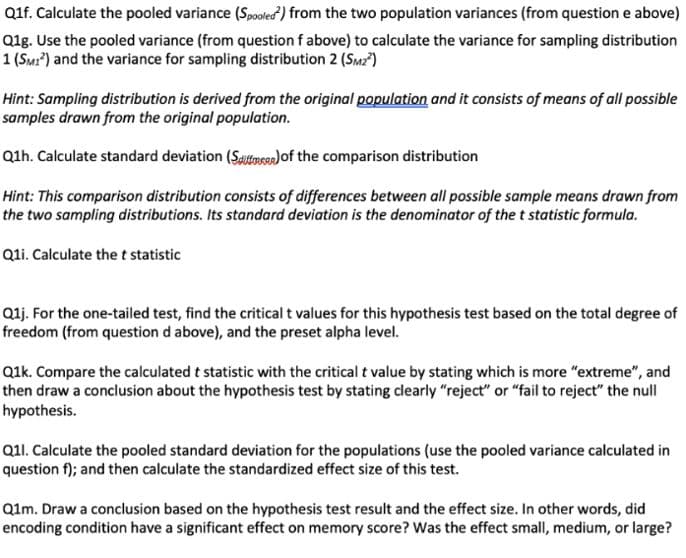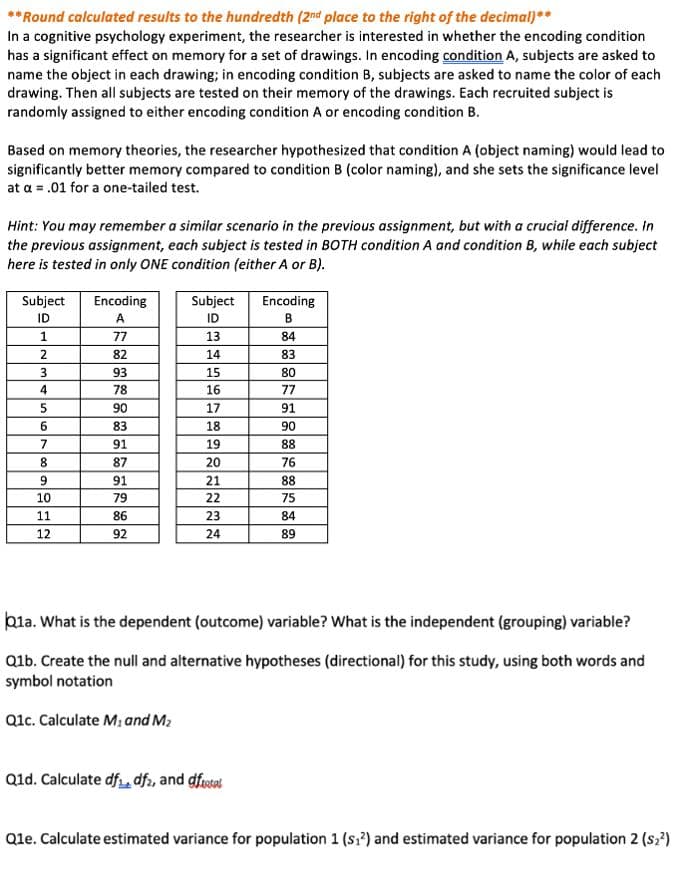Q1a. What is the dependent (outcome) variable? What is the independent (grouping) variable? Q1b. Create the null and alternative hypotheses (directional) for this study, using both words and symbol notation Q1c. Calculate M, and M₂ Q1d. Calculate dfdf2, and dfal Q1e. Calculate estimated variance for population 1 (s₁²) and estimated variance for population 2 (s₂²)
Q1a. What is the dependent (outcome) variable? What is the independent (grouping) variable? Q1b. Create the null and alternative hypotheses (directional) for this study, using both words and symbol notation Q1c. Calculate M, and M₂ Q1d. Calculate dfdf2, and dfal Q1e. Calculate estimated variance for population 1 (s₁²) and estimated variance for population 2 (s₂²)
Glencoe Algebra 1, Student Edition, 9780079039897, 0079039898, 2018
18th Edition
ISBN:9780079039897
Author:Carter
Publisher:Carter
Chapter10: Statistics
Section: Chapter Questions
Problem 27SGR
Related questions
Question
Please help me with the following question.

Transcribed Image Text:Q1f. Calculate the pooled variance (Spooled) from the two population variances (from question e above)
Q1g. Use the pooled variance (from question f above) to calculate the variance for sampling distribution
1 (SM1²) and the variance for sampling distribution 2 (SM2²)
Hint: Sampling distribution is derived from the original population and it consists of means of all possible
samples drawn from the original population.
Q1h. Calculate standard deviation (Sf) of the comparison distribution
Hint: This comparison distribution consists of differences between all possible sample means drawn from
the two sampling distributions. Its standard deviation is the denominator of the t statistic formula.
Q1i. Calculate the t statistic
Q1j. For the one-tailed test, find the critical t values for this hypothesis test based on the total degree of
freedom (from question d above), and the preset alpha level.
Q1k. Compare the calculated t statistic with the critical t value by stating which is more "extreme", and
then draw a conclusion about the hypothesis test by stating clearly "reject" or "fail to reject" the null
hypothesis.
Q1l. Calculate the pooled standard deviation for the populations (use the pooled variance calculated in
question f); and then calculate the standardized effect size of this test.
Q1m. Draw a conclusion based on the hypothesis test result and the effect size. In other words, did
encoding condition have a significant effect on memory score? Was the effect small, medium, or large?

Transcribed Image Text:**Round calculated results to the hundredth (2nd place to the right of the decimal)**
In a cognitive psychology experiment, the researcher is interested in whether the encoding condition
has a significant effect on memory for a set of drawings. In encoding condition A, subjects are asked to
name the object in each drawing; in encoding condition B, subjects are asked to name the color of each
drawing. Then all subjects are tested on their memory of the drawings. Each recruited subject is
randomly assigned to either encoding condition A or encoding condition B.
Based on memory theories, the researcher hypothesized that condition A (object naming) would lead to
significantly better memory compared to condition B (color naming), and she sets the significance level
at a = .01 for a one-tailed test.
Hint: You may remember a similar scenario in the previous assignment, but with a crucial difference. In
the previous assignment, each subject is tested in BOTH condition A and condition B, while each subject
here is tested in only ONE condition (either A or B).
Subject
ID
1
2
3
4
5
6
7
8
9
10
11
12
Encoding
A
77
82
93
78
90
83
91
87
91
79
86
92
Subject
ID
13
Q1c. Calculate M₁ and M₂
14
15
16
17
18
19
20
21
22
23
24
Encoding
B
Q1d. Calculate dfdf₂, and dfal
84
83
Q1a. What is the dependent (outcome) variable? What is the independent (grouping) variable?
Q1b. Create the null and alternative hypotheses (directional) for this study, using both words and
symbol notation
80
77
91
90
88
76
88
75
84
89
Q1e. Calculate estimated variance for population 1 (s₁²) and estimated variance for population 2 (s₂²)
Expert Solution
This question has been solved!
Explore an expertly crafted, step-by-step solution for a thorough understanding of key concepts.
This is a popular solution!
Trending now
This is a popular solution!
Step by step
Solved in 4 steps

Recommended textbooks for you

Glencoe Algebra 1, Student Edition, 9780079039897…
Algebra
ISBN:
9780079039897
Author:
Carter
Publisher:
McGraw Hill


College Algebra (MindTap Course List)
Algebra
ISBN:
9781305652231
Author:
R. David Gustafson, Jeff Hughes
Publisher:
Cengage Learning

Glencoe Algebra 1, Student Edition, 9780079039897…
Algebra
ISBN:
9780079039897
Author:
Carter
Publisher:
McGraw Hill


College Algebra (MindTap Course List)
Algebra
ISBN:
9781305652231
Author:
R. David Gustafson, Jeff Hughes
Publisher:
Cengage Learning

Holt Mcdougal Larson Pre-algebra: Student Edition…
Algebra
ISBN:
9780547587776
Author:
HOLT MCDOUGAL
Publisher:
HOLT MCDOUGAL

Algebra & Trigonometry with Analytic Geometry
Algebra
ISBN:
9781133382119
Author:
Swokowski
Publisher:
Cengage

Algebra and Trigonometry (MindTap Course List)
Algebra
ISBN:
9781305071742
Author:
James Stewart, Lothar Redlin, Saleem Watson
Publisher:
Cengage Learning